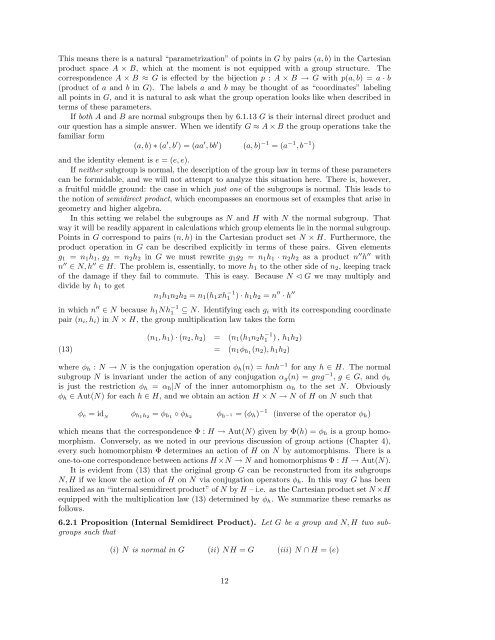Algebra I: Section 6. The structure of groups. 6.1 Direct products of ...
Algebra I: Section 6. The structure of groups. 6.1 Direct products of ...
Algebra I: Section 6. The structure of groups. 6.1 Direct products of ...
Create successful ePaper yourself
Turn your PDF publications into a flip-book with our unique Google optimized e-Paper software.
This means there is a natural “parametrization” <strong>of</strong> points in G by pairs (a, b) in the Cartesian<br />
product space A × B, which at the moment is not equipped with a group <strong>structure</strong>. <strong>The</strong><br />
correspondence A × B ≈ G is effected by the bijection p : A × B → G with p(a, b) = a · b<br />
(product <strong>of</strong> a and b in G). <strong>The</strong> labels a and b may be thought <strong>of</strong> as “coordinates” labeling<br />
all points in G, and it is natural to ask what the group operation looks like when described in<br />
terms <strong>of</strong> these parameters.<br />
If both A and B are normal sub<strong>groups</strong> then by <strong>6.</strong>1.13 G is their internal direct product and<br />
our question has a simple answer. When we identify G ≈ A × B the group operations take the<br />
familiar form<br />
(a, b) ∗ (a ′ , b ′ ) = (aa ′ , bb ′ ) (a, b) −1 = (a −1 , b −1 )<br />
and the identity element is e = (e, e).<br />
If neither subgroup is normal, the description <strong>of</strong> the group law in terms <strong>of</strong> these parameters<br />
can be formidable, and we will not attempt to analyze this situation here. <strong>The</strong>re is, however,<br />
a fruitful middle ground: the case in which just one <strong>of</strong> the sub<strong>groups</strong> is normal. This leads to<br />
the notion <strong>of</strong> semidirect product, which encompasses an enormous set <strong>of</strong> examples that arise in<br />
geometry and higher algebra.<br />
In this setting we relabel the sub<strong>groups</strong> as N and H with N the normal subgroup. That<br />
way it will be readily apparent in calculations which group elements lie in the normal subgroup.<br />
Points in G correspond to pairs (n, h) in the Cartesian product set N × H. Furthermore, the<br />
product operation in G can be described explicitly in terms <strong>of</strong> these pairs. Given elements<br />
g1 = n1h1, g2 = n2h2 in G we must rewrite g1g2 = n1h1 · n2h2 as a product n ′′ h ′′ with<br />
n ′′ ∈ N, h ′′ ∈ H. <strong>The</strong> problem is, essentially, to move h1 to the other side <strong>of</strong> n2, keeping track<br />
<strong>of</strong> the damage if they fail to commute. This is easy. Because N ⊳ G we may multiply and<br />
divide by h1 to get<br />
n1h1n2h2 = n1(h1xh −1<br />
1 ) · h1h2 = n ′′ · h ′′<br />
in which n ′′ ∈ N because h1Nh −1<br />
1 ⊆ N. Identifying each gi with its corresponding coordinate<br />
pair (ni, hi) in N × H, the group multiplication law takes the form<br />
(13)<br />
(n1, h1) · (n2, h2) = (n1(h1n2h −1<br />
1 ), h1h2)<br />
= (n1φh1(n2), h1h2)<br />
where φh : N → N is the conjugation operation φh(n) = hnh −1 for any h ∈ H. <strong>The</strong> normal<br />
subgroup N is invariant under the action <strong>of</strong> any conjugation αg(n) = gng −1 , g ∈ G, and φh<br />
is just the restriction φh = αh|N <strong>of</strong> the inner automorphism αh to the set N. Obviously<br />
φh ∈ Aut(N) for each h ∈ H, and we obtain an action H × N → N <strong>of</strong> H on N such that<br />
φe = id N φh1h2 = φh1 ◦ φh2 φ h −1 = (φh) −1 (inverse <strong>of</strong> the operator φh)<br />
which means that the correspondence Φ : H → Aut(N) given by Φ(h) = φh is a group homomorphism.<br />
Conversely, as we noted in our previous discussion <strong>of</strong> group actions (Chapter 4),<br />
every such homomorphism Φ determines an action <strong>of</strong> H on N by automorphisms. <strong>The</strong>re is a<br />
one-to-one correspondence between actions H ×N → N and homomorphisms Φ : H → Aut(N).<br />
It is evident from (13) that the original group G can be reconstructed from its sub<strong>groups</strong><br />
N, H if we know the action <strong>of</strong> H on N via conjugation operators φh. In this way G has been<br />
realized as an “internal semidirect product” <strong>of</strong> N by H – i.e. as the Cartesian product set N ×H<br />
equipped with the multiplication law (13) determined by φh. We summarize these remarks as<br />
follows.<br />
<strong>6.</strong>2.1 Proposition (Internal Semidirect Product). Let G be a group and N, H two sub<strong>groups</strong><br />
such that<br />
(i) N is normal in G (ii) NH = G (iii) N ∩ H = (e)<br />
12

















